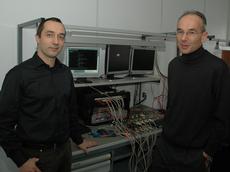Well positioned with GPS technology
Ten years ago three ETH Zurich doctoral students, a post-doc and a professor at the Institute of Electronics founded the company u-blox, which has grown to become number two in the world today as a manufacturer of positioning receivers. After a successful stock market flotation and pleasing growth rates in the past two years, u-blox is now progressing splendidly. However, the path to success was not always a very smooth one.

One professor, three motivated doctoral students, one post-doc and a resoundingly successful idea – this was the combination that led to the founding of the u-blox company in 1997. Together with his doctoral students and in the context of an EU project, Gerhard Tröster, Professor at the Institute of Electronics of ETH Zurich, built what was until then the smallest Global Positioning System (GPS). When this receiver, the size of a 5 franc coin, was first shown at an exhibition, the team was overwhelmed by the response. Tröster, who was himself a member of the management of u-blox for two and a half years and is still a board member today, recalls that “The industry’s demand for small GPS receivers was enormous.” The young entrepreneurs used the first three years to achieve marketability for satellite navigation technology employing their GPS microchips. None of the five participants had any entrepreneurial experience until then, but were able to rely on the commitment of their main investor at that time. U-blox received its first major order in 2000: u-blox was able to provide the technology needed to implement the Swiss Performance-related Heavy Vehicle Fee (HVF). GPS is used to locate the positions of heavy vehicles, and the mileage they drive is calculated automatically. The GPS modules were further improved and miniaturised, with the result that in 2002 the company was able to conclude a major order with the Finnish manufacturer Benefon to supply 50,000 GPS microchips per month to fabricate the world’s first GPS mobile phones. Then, on their fifth anniversary, came the big crash. The Benefon Company had financial difficulties, the chips that were produced could no longer be sold, and the debts to the module supplier Siemens went through the roof.
Out of the crisis by skilful management
Thomas Seiler, CEO of u-blox, now realises that “GPS technology at that time was still under-developed for a mass market product like a mobile phone.” Seiler was brought on board in the crisis year of 2002. Originally an ETH Zurich mechanical engineer and MBA graduate, he had already gained management experience in technology businesses such as Elektrowatt and Kistler.
Seiler diversified the customer portfolio, gave the company a better cost structure and systematically expanded its international sales and marketing. The GPS chip made by u-blox soon became the industry standard, with dozens of copies. In the meantime GPS chips have reached the fifth generation, the novel feature being that they could also receive signals from the European GALILEO system as well as those from the American GPS satellite system. “Could” because the GALILEO project has been delayed and the first satellites are not expected to come into operation until the first half of next year.
Mobile phones and cars as a future market
Measuring eight by eight millimetres and with minimal power requirement, the fifth generation chips can now also be used in mobile phones. Seiler expects strong growth in this area. He is convinced that “Mobile phones with GPS will soon become a mass market product.” This is a lucrative business with about a billion new mobile phones per year. This is what applications in mobile phones might look like: since the time and position information is constantly available, when a weather report is requested the mobile phone automatically recognises the region for which it is needed. The time and place could also be included in the record when photos are taken. And of course it will also be possible to ask one’s mobile phone the way to the nearest pizzeria.
The second lucrative market for u-blox is the automobile industry. Many manufacturers are now starting to fit their cars with GPS systems as standard, and here again the company wants to be one of the leading players. Current growth rates in the market for positioning technology are 40 percent or more. To enable u-blox to keep pace with this meteoric growth while still maintaining its independence, it needs sufficient capital. This is why the business was floated on the stock exchange in October 2007 with a capitalisation of 381 million Swiss francs. This made the company’s ten year anniversary a considerably happier event than its fifth birthday.
ETH Zurich was a great help at the start
When Daniel Ammann, one of the founders of u-blox, is asked whether he would risk taking the step to independence again, he doesn’t need to think for very long: “Ten years ago I was still not sure whether I would really prefer to complete my doctorate first. I would certainly not ask myself that question today.” Although there were still hardly any start-up workshops or business management courses when he was at ETH Zurich, he has good memories of the support provided by the institution. According to Ammann, “ETH Zurich provided us with workrooms and the technical infrastructure at favourable conditions. That was a great help in the beginning.”
However, Ammann also had to learn that infrastructure, technology and a good idea on their own still don’t earn any money. Sales and marketing are equally important. This becomes obvious when the staffing of the company, whose headquarters is in Thalwil, is looked at slightly more closely: only one third of the 69 employees work in technical development, the remainder look after marketing, distribution and support.







READER COMMENTS